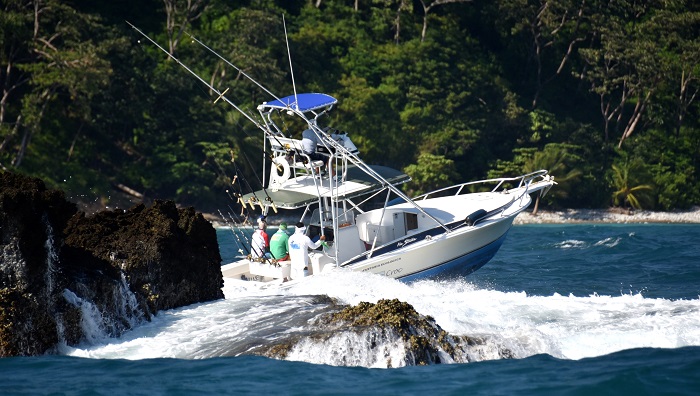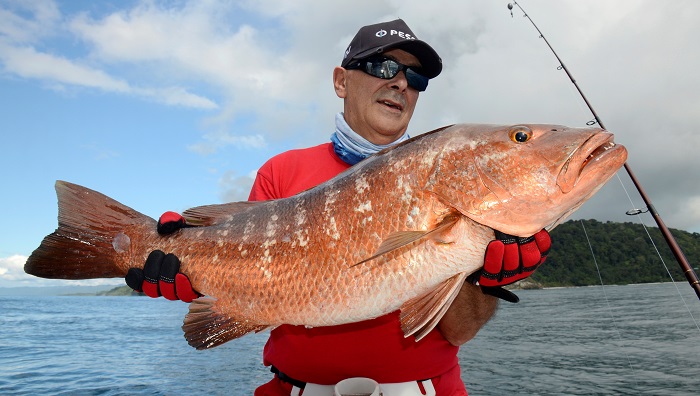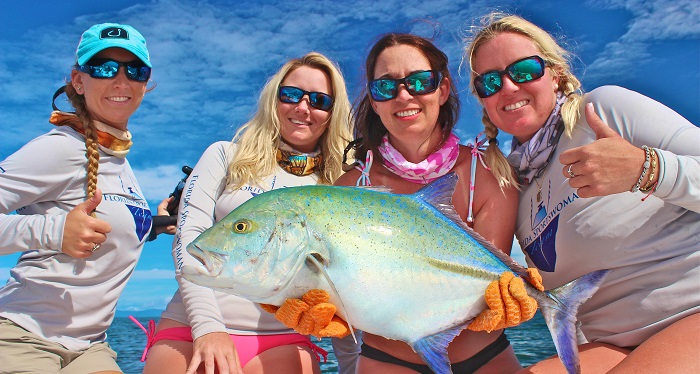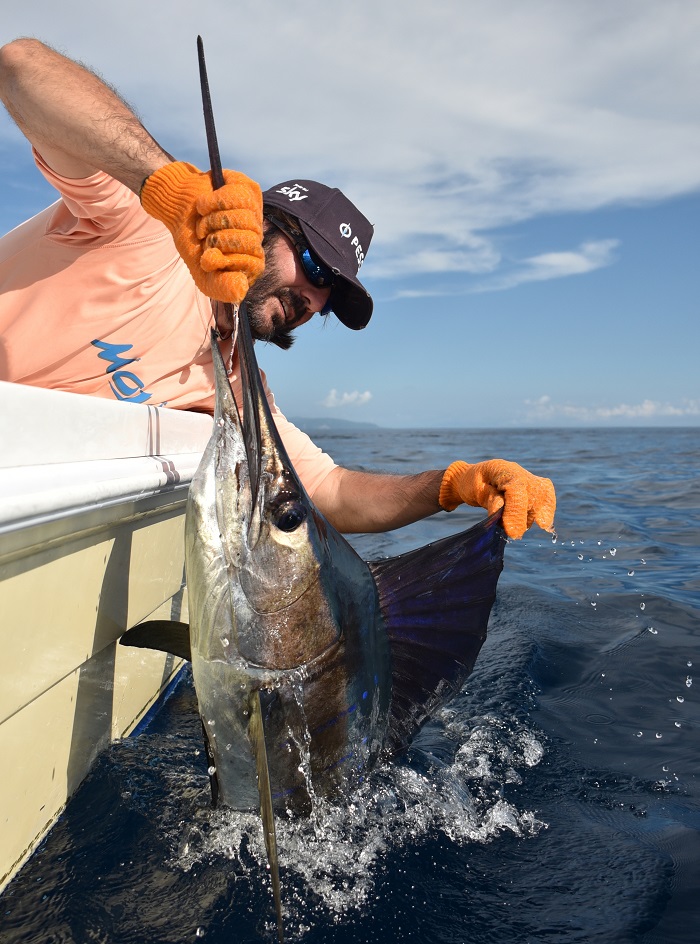Words By: Antonio Varcasia
There are 457. I counted them several times and it is a figure that is almost impossible to forget. These are the number of steps you have to take to cross the Crocodile Bay pier to board one of the boats of the famous lodge and leave for another day of fishing on the Pacific Ocean in Costa Rica.
As you cross that long pier many things come to your mind: the first is to give thanks for being there, kissed by the sun a few minutes from the beginning of a dream; or better, that your has dream finally come true.
Crocodile Bay is located near Puerto Jimenez in the Osa Peninsula southwest of Costa Rica overlooking the Pacific Ocean. The Rincon de Osa as it is called by locals is a very interesting spot because on one hand it closes the loop of the coast which is known as the Golfo Dulce, the other overlooking a stretch of untamed wilderness sea that quickly (15 miles approximately) finds the continental drop and many oxygenated waters where pelagic fishes love to swim in. In addition, the Osa Peninsula is known as a natural corridor for many animal species between the south of Costa Rica and closer countries and one of the most important national parks of the world, the Corcovado National Park. For this reason, it’s extremely easy to see animals that elsewhere are extremely rare like the scarlet macaw which you can see and hear directly from your habitation.
On the way to Jurassic Park…

Three hundred miles west of Crocodile Bay emerges from the ocean the most remote national park in Costa Rica, Cocos Island, where Isla Nublar of Jurassic Park fame takes its inspiration from.
Although Cocos is quite far, there are creatures at Crocodile Bay capable of arousing the emotions even of a longtime angler. In fact, inshore you can fish all the typical species of the eastern Pacific, there are at least six species of Jack (Pacific crevalle, bigeye trevally, blue runner, blue trevally, black jack, golden trevally) but also African pompano, several species of amberjack, roosterfish, barracuda, giant needlefish, Spanish mackerel. These species typical of the surface layers are catchable with topwater spinning or trolling.
In addition, there are the species that live in closer contact with the bottom as different species of Pargo, Cubera snapper and groupers, including the famous goliath, which reaches embarrassing sizes. Matapalo Rock roosterfish and Cuberas are known worldwide and several records have been placed here.

The inshore fishing has no seasonal variations like off-shore, which suffered more seasonal changes. The high season of off-shore starts in November, a time when there was a first run of about a month of marlins (black and blue in prevalence, and occasionally striped). December to April begins to grow exponentially the number of sailfish, that during the hot months (February/March), can really give great satisfaction with catches in double digit. The dorado are present throughout the year but during the rainy season (August) you can have a great time with them thanks to the large number of logs drifting. Tuna are present too, with at least two species of interest, the bigeye and yellowfin tuna above all, with widely varying sizes, but can also get to 200 pounds in weight. The yellowfins are normally intercepted between 15 and 20 miles following the spinners. One of four species of dolphins are in these waters (besides the bottlenose, the most common, or panzablanca and falsa orca, as they are called by locals). For lovers of marine mammals, the Osa Peninsula is also a great place to practice whale watching or dolphins tours.

Tropical weather and tides
For an angler used to fish in temperate weather, the main differences with which he must become familiar with are the meteorological conditions and the tides and understand how they affect fishing in Central America. The region of the humid tropics that encompasses all the countries of Central America is characterised by two main seasons: the dry season, which runs from November to April, and the wet season which takes place from May to October. This is true in general, because in the areas covered by forests and generally all over the Atlantic coasts of the countries of the isthmus, the rain is something that knows no season.
The tropical rain is not like the one you know in your country. You wake up with a beautiful sun that at 9:00 a.m. burns the skin. When the wind gets up at 12 and you start to see the clouds running down the horizon. In 10 minutes the water flows as if someone had forgotten an open faucet. This can last a few minutes, or even hours, with incredible intensity, able to change the landscape and the sea conditions dramatically.
The tide is another important parametre because the tidal range in the Osa Peninsula can range from 2.20 up to 2.70 metres and beyond. For people who come from the Mediterranean this is something shocking, if used to having the tidal 30cm. The tide completely changes the scenario of fishing, so putting a number of phenomena related to the current and the waves it generates, which are essential, especially if you are fishing in the coastal area most affected by this phenomenon, where your “piedra” were preferred to cast could easily be surrounded by sand or rocks!

The tide changes every six hours, in which we move from the peak of low to high peak, and then continue to follow this rhythm usually by delaying and moving forward about an hour every day (or at least the day before exiting). Knowing when is the peak of high tide if you want to fish inshore is essential, in order to organise your day and avoid wasting energy unnecessarily and destroy what is supposed to be a highlight. This is even truer for those who love to fish with a spinning: personally I go fishing inshore when I can optimally utilise the early hours of the day accompanied by a rising tide. However the peak of high is sacred and if you can it’s important to be there and give a before and after analysis. This is the best, knowing that it is harder to fish (usually the sea that enters creates current and raises the wave).
What to bring
All boats are fully equipped with inshore trolling and off-shore fishing gear, and on demand with jigging and fly fishing rods and some spinning rods. So depending on the kind of fishing you like, you can leave at home all the hardware. For those who are popping and spinning fanatics it is recommended to bring at least two rods, a 20-30lbs that can cast up to 2oz to fish inshore, with a reel of class 5000 or 6000 (high ratio) with 50lbs braid for all the inshore pelagic species. A second rod, of 30-50lbs with a casting rate of 3oz with a good backbone is suggested for big Cuberas, XXXL roosterfish and big yellowfin tuna paired with a reel of 10000/14000 class with excellent drag and filled with 60-80 pounds braided. Both types of rods can be used to have fun with the switch and bait with sailfish and dorado, if you are not used to trolling reels. Bring a bunch of topwater lures, like skipping and WTD, pencils and poppers generously sized. For those who have never had the pleasure of fishing in these conditions it is recommended to wear technical clothing with UPF filter of at least 30 or better yet, 50; polarising glasses and sunscreen suitable for your complexion (at least 30); and for those who like popping or spinning a good security device is recommended, such as Restube.
Why CBR?
Getting there:
To get to Crocodile Bay you must reach the capital of Costa Rica, San Jose and then take a small domestic flight with the company Nature Air . You need to book early to get to Puerto Jimenez. The lodge is located a few metres from the small town. The resort has a very efficient reception and their staff usually welcomes you at airports. To get to Costa Rica from Europe you have two choices: from the US, via Atlanta (Delta) or Miami (American Airlines), and then catch a 3-4 hours flight to the Central American capital. The flight from the USA is more cost effective and provides more alternatives. The only negative is you have to do a visa even for transit and have an electronic passport approved by USA. The alternative is a direct flight from Europe to SJC, possible at this time through Madrid (Iberia) or Amsterdam (KLM), which is more comfortable but generally more expensive. Depending on the flight you choose, inevitably you will need to spend a night in USA or in San Jose before you get to the resort, I recommend the beautiful Hotel Martino.

